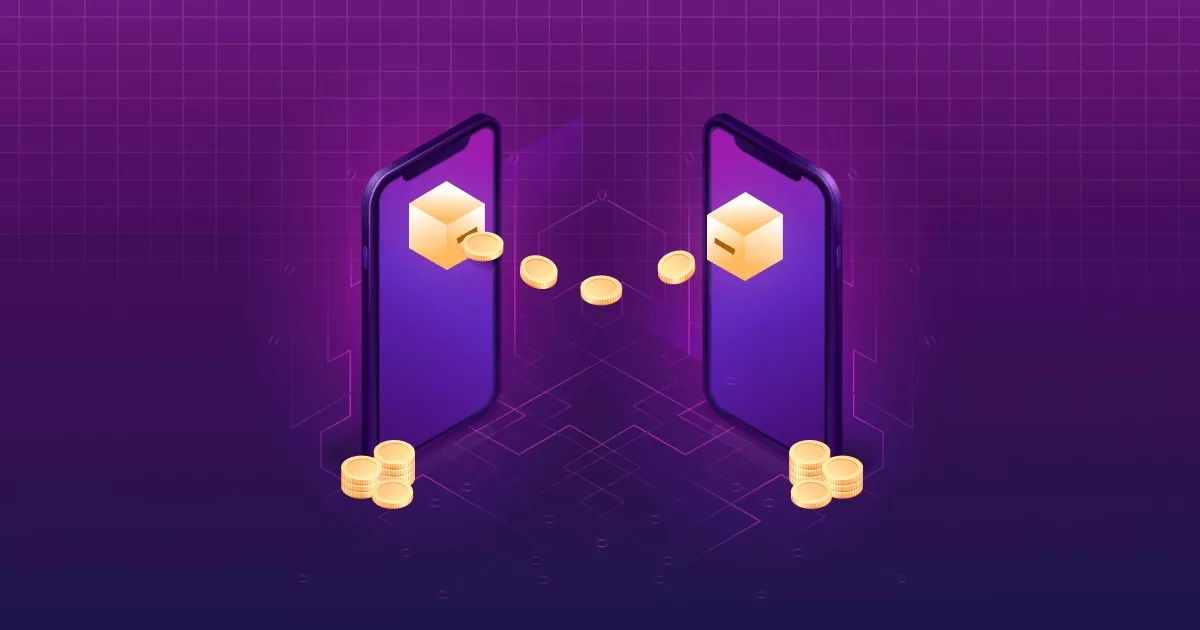
In recent years, blockchain technology has become increasingly popular. Many industries and individuals recognize its potential to transform the way we do business. One of the most important aspects of blockchain technology is the concept of transactions. Transactions are basically the backbone of blockchain technology, enabling the movement of digital assets and information in a secure and transparent way. But how does it all work?
In this blog, we will explore what transactions are in a blockchain, how they work, and their role in enabling the various use cases of blockchain technology. We will also dive into the different types of transactions that exist, how they are verified and processed, and the security measures in place to ensure their integrity.
What Is a Transaction in Blockchain?
In simple terms, a transaction is a record of the transfer of something valuable from one person to another. This could be money, property, or even something like a vote or a message.
Now, imagine a digital version of this process. In a blockchain network, transactions are recorded in a block and added to a chain of blocks. These form a secure and transparent ledger of all the transactions that people have made on the network. So, if someone wants to send a cryptocurrency like Bitcoin to someone else, they would create a transaction and send it to the network. The network would then verify the transaction to ensure that the sender has enough Bitcoin to send and that the recipient is a valid address.
Once a miner verifies the transaction, they add it to a block of transactions. They then add this block to the blockchain, forming a permanent and unchangeable record of the transaction. The key benefit of using blockchain technology for transactions is that it eliminates the need for a central authority, like a bank or a government, to oversee and approve transactions. Instead, the network of participants collectively verifies and approves transactions, making the process more secure, efficient, and transparent.
Key Elements of a Transaction
1. Inputs
The inputs of a transaction refer to the sources of value that fund the transaction. In a blockchain network, these inputs are typically in the form of cryptocurrency or other digital assets. To create a transaction, the sender must have sufficient inputs to cover the amount they wish to send, plus any associated transaction fees.
2. Outputs
The outputs of a transaction refer to the destinations of the transfer value. In other words, it’s the recipient of the transaction. In a blockchain network, these outputs are typically in the form of cryptocurrency or other digital assets. Each output specifies the amount of transfer value and the recipient’s address.
3. Transaction ID
The blockchain assigns a unique identifier, called a transaction ID, to each transaction. It generates this ID using a cryptographic hash function, which produces a fixed-length string of characters that uniquely identifies the transaction. This ID allows users to track the status of the transaction and confirm its successful addition to the blockchain.
4. Timestamp
When you create a transaction, it records the date and time of its creation as a timestamp. This is important for tracking the order of transactions on the blockchain, as well as for verifying the validity of a transaction. The timestamp is typically recorded in Unix time, which is a standard way of representing time as the number of seconds elapsed since January 1, 1970.
Together, these elements form the basic structure of a transaction on the blockchain. By specifying the inputs, outputs, transaction ID, and timestamp, blockchain transactions are able to record and verify the transfer of value in a secure and transparent way.
The Transaction Process
1. Transaction Initiation
The first step in a blockchain transaction is the initiation of the transaction. This is where the sender creates a transaction and specifies the inputs, outputs, and the amount of the transfer value. Once the transaction is created, it is broadcast to the network and waiting to be verified and processed.
2. Transaction Verification
The next step is transaction verification. In a blockchain network, transactions are verified by a decentralized network of nodes or validators. These nodes verify that the sender has sufficient inputs to cover the transfer amount and that the recipient’s address is valid. Once the transaction is verified, it is added to a pool of unconfirmed transactions waiting to be validated.
3. Transaction Validation
The third step is transaction validation. In order to be added to the blockchain, transactions must be validated by the network. This is typically done through a consensus mechanism, such as proof-of-work or proof-of-stake, which ensures that the transaction is valid and secure. Once the transaction is validated, it is added to a block of transactions and broadcast to the network.
4. Transaction Confirmation
The final step in a blockchain transaction is confirmation. This is where the transaction is added to the blockchain and becomes a permanent and immutable record of the transfer of value. Confirmation can take several minutes to several hours, depending on the blockchain network and the transaction fees paid by the sender. Once the transaction is confirmed, it can be considered complete, and the recipient can use the transferred value.
Types of Transactions in Blockchain
1. Regular transactions
Regular transactions are the most common type of transaction on the blockchain. There are two types of regular transactions:
2. Single Output Transactions
A single output transaction is a simple transaction where the sender sends value to a single recipient. This is the most basic type of transaction on the blockchain.
3. Multi-Output Transactions
A multi-output transaction is a more complex transaction where the sender sends value to multiple recipients in a single transaction. This is useful for situations where the sender wants to send value to multiple parties at once.
4. Advanced transactions
In addition to regular transactions, there are also advanced transactions that can occur on the blockchain. These are transactions that involve more complex conditions or requirements. Here are two examples of advanced transactions:
5. Multi-Signature Transactions
A multi-signature transaction is a transaction that requires more than one signature to be validated. This is useful for situations where multiple parties need to approve a transaction before it can be executed. For example, a company may require multiple signatures to approve a large payment.
6. Smart Contract Transactions
A smart contract transaction is a transaction that is executed automatically based on a pre-determined set of rules or conditions. Smart contracts are self-executing contracts that use blockchain technology to enforce the terms of the contract. For example, a smart contract could be used to automatically transfer ownership of a property once the buyer has paid the seller.
Transaction Fees in Blockchain
When you initiate a transaction on a blockchain network, you must pay a fee to have the transaction processed and added to the blockchain. This fee is called a transaction fee, and it’s paid to the miners or validators who are responsible for processing transactions on the network.
Why Are Transaction Fees Necessary?
Transaction fees are necessary for a few reasons:
They incentivize miners or validators to process transactions. Without transaction fees, miners or validators would have little motivation to prioritize certain transactions over others.
They help protect the network from spam and denial-of-service attacks. By requiring a fee to process a transaction, it becomes more difficult for attackers to flood the network with invalid or fraudulent transactions.
How Are Transaction Fees Determined?
The blockchain network determines transaction fees based on the supply and demand of block space. In other words, when there are more transactions waiting for processing than there is available block space, transaction fees will be higher. Conversely, when there are fewer transactions waiting for processing, transaction fees will be lower.
You typically calculate transaction fees based on the size of the transaction in bytes rather than the transfer amount. This is because larger transactions require more computational resources to process and verify.
Transaction Security in Blockchain
Transaction security is a crucial aspect of blockchain technology, as it ensures that the transfer of value is secure, transparent, and tamper-proof. Here are a few important factors to consider when it comes to transaction security:
1. Double Spending
One of the biggest threats to transaction security is double-spending. This is when a user tries to spend the same digital asset more than once. In a blockchain network, each transaction is verified by a network of nodes to ensure that the sender has sufficient funds to complete the transaction. To prevent double spending, blockchain networks use a consensus mechanism, such as proof-of-work or proof-of-stake, which requires that a majority of nodes agree on the validity of each transaction.
2. 51% Attack
Another potential threat to transaction security is a 51% attack. This is when a single entity or group of entities control more than 50% of the computing power on the network, allowing them to potentially manipulate the blockchain by reversing transactions or double-spending. To prevent a 51% attack, blockchain networks rely on a distributed network of nodes, which makes it difficult for any one entity to control the majority of the computing power on the network.
3. Prevention Measures
To prevent these types of attacks, blockchain networks have implemented various prevention measures, such as:
- Consensus mechanisms: As mentioned, consensus mechanisms like proof-of-work and proof-of-stake require nodes to agree on the validity of each transaction, preventing double spending and other types of attacks.
- Cryptography: Cryptography secures transactions and protects user privacy on the blockchain. Each transaction is cryptographically signed to ensure that only the intended recipient can access the transferred value.
- Decentralization: By distributing the network among a large number of nodes, blockchain networks are able to prevent any one entity from controlling the majority of the network’s computing power.
Conclusion
Blockchain transactions are a fascinating and essential part of blockchain technology. Without transactions, blockchains would not exist, as they are the building blocks that enable the transfer of value and information on the blockchain network. However, blockchain transactions are not without their challenges.
Despite these challenges, blockchain transactions have tremendous potential for revolutionizing the way we conduct transactions, transfer value, and exchange information. As the blockchain industry continues to evolve, we can expect to see even more exciting developments in this space.
FAQs
1. What is the purpose of a transaction in blockchain?
The purpose of a transaction in blockchain is to transfer value or information from one participant to another without the need for a central authority. Transactions are the building blocks of the blockchain network, allowing participants to interact in a trustless and decentralized way.
2:.How does a blockchain determine the transaction fee?
Supply and demand of block space on the network determine the transaction fees in a blockchain. When there are more transactions waiting to be processed than there is available block space, transaction fees will be higher. Conversely, when there are fewer transactions waiting to be processed, transaction fees will be lower.
3. What is a 51% attack in relation to blockchain transactions?
A 51% attack is a potential threat to the security of blockchain transactions. It occurs when a single entity or group of entities control more than 50% of the computing power on the network, allowing them to potentially manipulate the blockchain by reversing transactions or double-spending. Blockchain networks have implemented prevention measures, such as decentralization and consensus mechanisms, to prevent such attacks.





